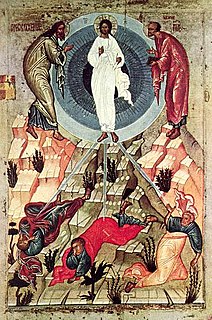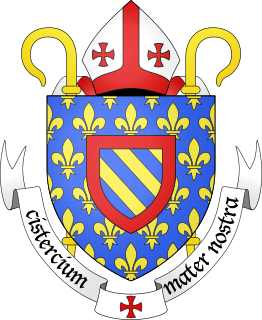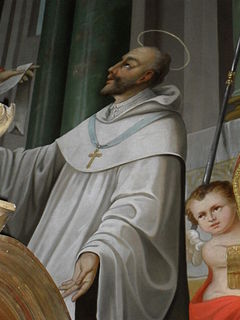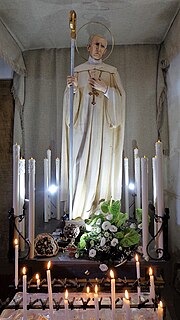
Bernard of Clairvaux, venerated as Saint Bernard, was a Burgundian abbot and a major leader in the revitalization of Benedictine monasticism through the nascent Cistercian Order.
Pope Eugene III, born Bernardo Pignatelli, or possibly Paganelli, called Bernardo da Pisa, was head of the Catholic Church and ruler of the Papal States from 15 February 1145 to his death in 1153. He was the first Cistercian to become pope. In response to the fall of Edessa to the Muslims in 1144, Eugene proclaimed the Second Crusade. The crusade failed to recapture Edessa, which was the first of many failures by the Christians in the crusades to recapture lands won in the First Crusade. He was beatified in 1872 by Pope Pius IX.

Cîteaux Abbey is a Catholic abbey located in Saint-Nicolas-lès-Cîteaux, south of Dijon, France. It is notable for being the original house of the Cistercian order. Today, it belongs to the Trappists.

The Cistercians, officially the Order of Cistercians, are a Catholic religious order of monks and nuns that branched off from the Benedictines and follow the Rule of Saint Benedict. They are also known as Bernardines, after the highly influential Bernard of Clairvaux or as White Monks, in reference to the colour of the "cuculla" or cowl worn by the Cistercians over their habits, as opposed to the black cowl worn by Benedictines.
Saint Bernard, St. Bernard, St Bernard or San Bernard may refer to:

Malachy was an Irish saint and Archbishop of Armagh, to whom were attributed several miracles and an alleged vision of 112 popes later attributed to the apocryphal Prophecy of the Popes.

Stephen Harding was an English-born monk and abbot, who was one of the founders of the Cistercian Order. He is honored as a saint in the Roman Catholic Church.
Saint Gerard or Gérard may refer to:

The Abbot and then Commendator of Melrose was the head of the monastic community of Melrose Abbey, in Melrose in the Borders region of Scotland. The abbots of the earlier Northumbrian foundation from Lindisfarne are not included here. The second abbey was founded in 1136 on the patronage of David I, King of Scots, by Cistercian monks from Rievaulx Abbey, Yorkshire. Control of the abbey was secularized in the 16th century and after the accession of James Stewart, the abbey was held by commendators. The last commendator, James Douglas of Lochleven, resigned the abbacy to William Douglas, 6th Earl of Morton in December 1606, and the abbey itself to the king in 1608. The abbey was then erected into a secular lordship for viscount Haddington, John Ramsay, who in 1609 was created "Lord Melrose". Lochleven however resumed the title of commendator in 1613 until his death in 1620.

William of Saint-Thierry was a twelfth-century Benedictine, theologian and mystic from Liège who became abbot of Saint-Thierry in France, and later joined the Cistercian Order.
Geoffrey of Clairvaux, or Geoffrey of Auxerre, was the secretary and biographer of Bernard of Clairvaux and later abbot of a number of monasteries in the Cistercian tradition.
Henry of Marcy (c. 1136 – 1 January 1189 was a Cistercian abbot first of Hautecombe and then of Clairvaux from 1177 until 1179. He was created Cardinal Bishop of Albano at the Third Lateran Council in 1179.
Gerard is a masculine forename of Proto-Germanic origin, variations of which exist in many Germanic and Romance languages. Like many other early Germanic names, it is dithematic, consisting of two meaningful constituents put together. In this case, those constituents are gari > ger- and -hard.
Gerard of Clairvaux was the older brother of Bernard of Clairvaux. He was the son of Tescelin le Roux and Aleth de Montbard. When Bernard entered Cîteaux with a group of young relatives and friends in 1112, Gerard did not join him. Instead, he participated in the military life, but was injured during a siege of Grancy and was also imprisoned. During his imprisonment, he decided to enter the monastic life and went to Citeaux after his release.

Doctor Mellifluus is an encyclical of Pope Pius XII on the Doctor of the Church Bernard of Clairvaux, given at Rome, St. Peter's, on the 24th of May, on the feast of Pentecost, 1953, in the 15th year of his pontificate. In issuing it in anticipation of the eight centenary of Bernard's death, Pius took the occasion to highlight Bernard's contributions to practical spirituality.

Hugh of Noara or of Novara, also known as Ugo of Novara and Hugo of Novara, was a Cistercian monk and a disciple of Bernard of Clairvaux. French by birth, he served as the first abbot of Novara Abbey, Sicily, where he remained until his death in 1170.

Cambron Abbey was a Cistercian abbey in Belgium, in Cambron-Casteau in the municipality of Brugelette in the Province of Hainaut. It was on the River Blanche, a tributary of the Dendre, about nine kilometres to the south-east of Ath. Dissolved in 1782, parts of the abbey still survive as ruins.

Igny Abbey or Val d'Igny Abbey is a Cistercian abbey located in Arcis-le-Ponsart, Marne, France. It was founded in 1128 for Cistercian monks, dissolved in 1791 during the French Revolution, re-established in 1876 for Trappist monks, destroyed in 1918, reopened in 1929 for Trappist nuns and modernised in 2008–12 to accommodate three or four pre-existing communities.

Blessed Gerard of Clairvaux was the sixth abbot of Clairvaux. He was murdered by a rebellious monk and is counted as the first Cistercian martyr.











